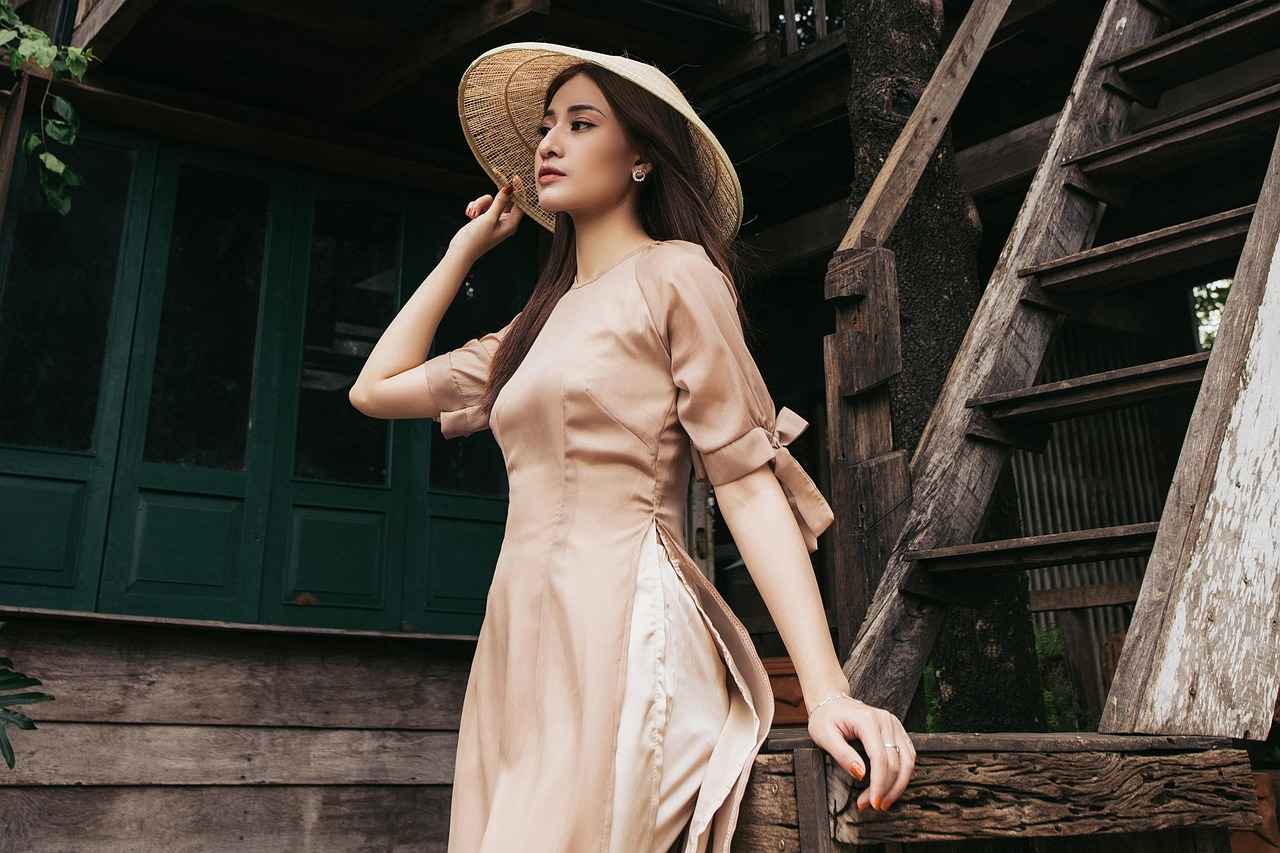This article provides a comprehensive guide on selecting the perfect night dress that balances warmth with comfort, ensuring you stay cozy without feeling overheated during the night. Choosing the right night dress is essential for a good night’s sleep, especially in varying temperatures. Here, we delve into the factors that contribute to finding the ideal nightwear.
Choosing the right fabric is crucial. Look for materials that provide insulation yet allow breathability. Cotton, flannel, and bamboo blends are excellent choices. These fabrics not only keep you warm but also wick moisture away from the skin, preventing that uncomfortable clammy feeling.
The fit of your night dress can greatly influence your comfort level. Opt for loose-fitting styles that allow for movement and airflow. Avoid tight or restrictive designs, as they can lead to discomfort and overheating during the night.
The length of your night dress can significantly affect warmth. In colder months, longer styles provide more coverage and insulation, while shorter options may be suitable for milder temperatures. Consider having a variety of lengths in your wardrobe to adapt to seasonal changes.
Layering can enhance warmth without causing overheating. Consider pairing your night dress with a lightweight robe or thermal leggings for added insulation. This way, you can easily adjust your layers based on how warm or cool you feel throughout the night.
The color and design of your night dress can influence heat retention. Dark colors absorb more heat, while lighter shades may keep you cooler. Choose colors based on your preferences and the climate you are in, ensuring a balance that suits your needs.
Understanding your body type can help you choose a night dress that flatters and keeps you warm. Styles like A-line or wrap dresses often suit various shapes and sizes effectively, providing both comfort and style.
Breathability is vital for regulating body temperature. Fabrics that wick moisture away from the skin can prevent overheating, making them ideal for night dresses. Look for dresses that feature mesh panels or ventilation to enhance airflow.
Consider features like adjustable straps, pockets, and closures. These elements can enhance functionality and comfort, ensuring your night dress meets your needs. A well-designed dress can significantly improve your nighttime experience.
Proper care extends the life and warmth of your night dress. Follow washing instructions carefully and consider air drying to preserve fabric integrity. Regular maintenance ensures that your favorite nightwear continues to perform well.
Sustainability is increasingly important. Look for brands that offer eco-friendly materials and ethical manufacturing practices. This not only contributes to your comfort but also supports environmental responsibility.
Personal preference is key. Whether you prefer a classic look or trendy designs, selecting a night dress that reflects your style will enhance your comfort and satisfaction. Always choose what makes you feel good!
Testing the warmth of a night dress is essential. Look for reviews, feel the fabric, or try it on in-store to ensure it meets your comfort and warmth requirements. Don’t hesitate to ask for recommendations based on your specific needs.

What Fabrics Are Best for Warmth Without Overheating?
When it comes to choosing the perfect night dress, one of the most critical factors to consider is the fabric. The right fabric not only affects your comfort but also plays a significant role in regulating your body temperature throughout the night. Let’s explore some of the best fabric options that offer warmth without the risk of overheating.
Cotton is a popular choice for nightwear due to its natural breathability and softness. It allows air to circulate, which helps in regulating body temperature. Additionally, cotton is moisture-wicking, meaning it can absorb sweat and keep you dry, making it an excellent option for those who tend to get warm at night.
Flannel, made from cotton or a cotton blend, is another fantastic fabric for warmth. Its brushed surface creates a cozy feel while providing insulation. Flannel is particularly suitable for colder months, as it traps heat effectively. However, it’s essential to choose lightweight flannel to avoid feeling weighed down.
Bamboo blends have gained popularity in recent years due to their eco-friendly properties and inherent breathability. Bamboo fabric is known for its ability to wick moisture away from the skin, keeping you comfortable and dry. This fabric is also naturally hypoallergenic and antibacterial, making it an excellent choice for sensitive skin.
For those who prefer a touch of luxury, consider modal or micromodal. These fabrics are derived from beech tree pulp and are incredibly soft and breathable. Modal has excellent moisture-wicking properties, ensuring you stay dry and comfortable throughout the night. Its smooth texture also adds a touch of elegance to your nightwear.
Another option to consider is merino wool. While it may seem counterintuitive to wear wool at night, merino wool is lightweight and breathable, making it suitable for sleepwear. This fabric regulates temperature effectively, keeping you warm in winter and cool in summer. Its natural elasticity allows for a comfortable fit without being restrictive.
When selecting fabrics, it’s also essential to consider blends. Fabrics that combine different materials often offer the best of both worlds. For instance, a cotton-polyester blend can provide the breathability of cotton while enhancing durability and wrinkle resistance. Look for blends that incorporate materials known for their moisture-wicking properties to ensure you stay comfortable.
In summary, when choosing a night dress, prioritize fabrics that offer warmth without compromising breathability. Cotton, flannel, bamboo blends, modal, and merino wool are excellent options that cater to different preferences and needs. By selecting the right fabric, you can enjoy a restful night’s sleep without the discomfort of overheating.

How to Choose the Right Fit for Comfort?
When it comes to selecting the perfect night dress, the fit is one of the most crucial factors that can significantly influence your overall comfort level. Choosing a night dress that feels good against your skin and allows you to move freely is essential for a restful night’s sleep. Here are some key aspects to consider when determining the right fit for your night dress.
- Loose-Fitting Styles: Opting for loose-fitting designs is highly recommended. These styles provide ample room for movement, ensuring that you can toss and turn comfortably without feeling restricted. A night dress that is too tight can lead to discomfort and disrupt your sleep.
- Airflow and Breathability: A well-fitted night dress should also allow for proper airflow. Fabrics that cling to the body can trap heat and moisture, leading to an uncomfortable sleeping experience. Look for night dresses that feature breathable materials and designs that promote airflow.
- Adjustable Features: Consider night dresses with adjustable straps or waistbands. These features allow you to customize the fit according to your body shape and personal comfort preferences. This adaptability can make a significant difference in how the dress feels throughout the night.
- Length Matters: The length of your night dress can also impact comfort. While longer styles may provide more coverage and warmth, they should not be so long that they hinder your movement. Conversely, shorter night dresses can be great for warmer nights but may not provide enough warmth during cooler months.
- Body Type Considerations: Understanding your body type can help you select a night dress that flatters your figure while ensuring comfort. A-line or wrap styles are often versatile options that suit various body shapes, providing a comfortable fit without being overly tight.
In addition to these considerations, it is essential to remember that personal preference plays a significant role in choosing the right fit. Some individuals may prefer a more fitted style, while others may gravitate towards looser designs. Ultimately, the goal is to find a night dress that not only looks good but also feels good against your skin.
When trying on night dresses, pay attention to how the fabric feels during movement. If you find yourself constantly adjusting or pulling at the dress, it may not be the right fit for you. Always prioritize comfort over style; after all, a good night’s sleep is worth it.
Lastly, don’t hesitate to experiment with different styles and fits. The right night dress can make a world of difference in your sleep quality, so take the time to explore various options until you find the perfect one that meets your comfort needs.

What Length Should You Consider for Different Seasons?
When selecting the perfect night dress, one of the most important factors to consider is the length of the garment. The length of your night dress can significantly influence how warm you feel while sleeping, especially as the seasons change. Understanding this relationship will help you make informed choices that keep you comfortable throughout the year.
During the colder months, longer night dresses are generally more beneficial. These styles typically extend to the ankles or mid-calf, providing ample coverage that helps to retain body heat. The extra fabric acts as a barrier against chilly air, ensuring that you stay warm and cozy throughout the night. Additionally, many longer designs come with features like long sleeves or higher necklines, which further enhance warmth.
On the other hand, as temperatures rise in the spring and summer, shorter night dresses become more appealing. Options like knee-length or above-the-knee styles allow for better airflow and ventilation, which can help prevent overheating. Fabrics that are light and breathable, paired with a shorter cut, can keep you comfortable on warmer nights.
In transitional seasons like autumn and early spring, it’s wise to consider medium-length night dresses. These styles typically fall between the knee and ankle, offering a balance of coverage and breathability. They can be paired with layers, such as a lightweight cardigan or a cozy robe, allowing you to adjust your warmth as needed. This flexibility is crucial during seasons when temperatures can fluctuate significantly throughout the day and night.
- Long Night Dresses: Look for styles with thermal materials or added insulation for maximum warmth.
- Knee-Length Dresses: Opt for breathable fabrics like cotton or bamboo blends, which are perfect for mild temperatures.
- Short Dresses: Ideal for summer nights, choose lightweight, moisture-wicking materials to keep you cool.
Your personal style and comfort preferences also play a significant role in selecting the right length for your night dress. Some individuals may prefer the elegance of a long gown, while others might find shorter styles more practical. It’s essential to choose a length that not only suits the season but also aligns with your comfort level and aesthetic taste.
Layering can be a fantastic strategy to enhance warmth without sacrificing style. For instance, pairing a longer night dress with a snug thermal robe can provide additional insulation during the winter months. Conversely, a short night dress can be layered with leggings or thermal tights for added warmth without compromising on comfort. This versatility allows you to adapt to varying temperatures throughout the night.
In summary, the length of your night dress is a crucial factor in maintaining warmth and comfort as the seasons change. By understanding how different lengths affect warmth, you can make informed choices that suit your personal style and seasonal needs. Whether you opt for a long, cozy gown in winter or a breezy short dress in summer, the right length will ensure that you sleep soundly and comfortably all year round.

Are Layering Techniques Effective for Staying Warm?
When it comes to staying warm during the chilly nights, layering techniques can be a game changer. By combining different pieces of clothing, you can effectively enhance warmth without the risk of overheating. This approach allows for versatility and comfort, making it an ideal choice for nighttime wear.
One effective method of layering is to pair your night dress with additional items that provide insulation. For instance, consider adding a lightweight robe that not only offers warmth but also adds a touch of elegance to your nighttime attire. A robe made from breathable materials like cotton or modal can keep you cozy without trapping excess heat.
Another excellent option is to incorporate thermal leggings or tights under your night dress. These items are designed to provide warmth while still allowing for breathability. Look for thermal leggings made from moisture-wicking fabrics, which help manage body temperature by drawing sweat away from the skin. This combination of a night dress with thermal leggings ensures you stay warm without feeling stifled.
Additionally, layering doesn’t just stop at clothing. Consider using bedroom accessories like blankets or throws that can be added or removed as needed. A soft, lightweight blanket can provide extra warmth during colder nights, and you can easily toss it aside if you start to feel too warm. This flexibility is key to maintaining comfort throughout the night.
When layering, it’s essential to pay attention to the fit and fabric of each garment. Ensure that the pieces you choose are not too tight, as this can restrict airflow and lead to discomfort. Loose-fitting layers allow for better circulation and help regulate body temperature, preventing overheating.
Moreover, consider the weather conditions in your area. For instance, if you live in a particularly cold climate, you might want to opt for thicker, insulated materials for your robe or leggings. Conversely, in milder weather, lighter fabrics may suffice. This adaptability is crucial for effective layering.
Don’t forget about the color and design of your layering pieces, as these can also impact warmth. Darker colors tend to absorb heat, making them a good choice for colder nights, while lighter shades can help keep you cool. Choose colors that not only suit your style but also align with your warmth needs.
Lastly, layering can be both functional and fashionable. With a variety of styles available, you can express your personal taste while staying warm. Whether you prefer a classic look or something more modern, there are plenty of options to explore.
In summary, layering techniques are indeed effective for staying warm without the fear of overheating. By thoughtfully combining your night dress with lightweight robes or thermal leggings, you can achieve the perfect balance of comfort and warmth. Remember to consider fit, fabric, and personal style when selecting your layers, and you’ll be well on your way to a cozy night’s sleep.

How Do Color and Design Impact Warmth?
When selecting a night dress, one of the often-overlooked factors is the color and design of the garment. These elements can significantly impact how warm or cool you feel while sleeping. Understanding how different colors interact with heat can help you make more informed choices that align with your comfort needs.
Colors have varying abilities to absorb and reflect heat. Dark colors, such as black or navy, tend to absorb more heat from the environment, which can be beneficial in cooler climates or during winter months. Conversely, lighter shades, like pastels or whites, reflect sunlight and heat, making them ideal for warmer seasons or climates. This basic principle of color theory can guide you in selecting night dresses that suit your temperature preferences.
Beyond color, the design of your night dress also plays a crucial role in warmth retention. For instance, dresses with long sleeves and full-length skirts provide more coverage and are generally warmer than their short-sleeved or knee-length counterparts. Additionally, layered designs can trap air close to the body, providing insulation without causing overheating.
- Cooler Seasons: Opt for darker hues to retain warmth.
- Warmer Seasons: Choose lighter colors to promote airflow and keep cool.
- Personal Preference: Select colors that resonate with your style while considering their thermal properties.
While the color itself is vital, the patterns on your night dress can also affect how warm you feel. Complex patterns may visually suggest warmth and coziness, while simple, minimalist designs can feel more refreshing. However, it’s essential to remember that the actual warmth provided will largely depend on the fabric and color rather than just the pattern.
While color and design are important, the material of your night dress often plays a more significant role in temperature regulation. Fabrics like flannel or bamboo blends provide excellent insulation and breathability, making them suitable choices regardless of color. A dark flannel night dress will keep you warm, while a light cotton dress may allow for better airflow.
Ultimately, the choice of color and design should reflect your personal style and comfort. If you feel more relaxed in a particular color or design, you are likely to have a better night’s sleep. Consider trying on different colors and styles to see which ones make you feel the most comfortable and warm.
In summary, the color and design of your night dress can significantly influence your warmth during sleep. By understanding how different colors absorb heat and how design elements contribute to insulation, you can make choices that enhance your nighttime comfort. Remember to pair your color and design choices with suitable materials for the best results.

What Styles Are Best for Different Body Types?
When it comes to selecting the perfect night dress, understanding your body type is essential for both comfort and style. The right choice can not only enhance your appearance but also keep you warm during those chilly nights. Here’s a detailed guide to help you navigate the various styles that best suit different body types.
A-line night dresses are a popular choice for many women due to their versatility. They gently flare out from the waist, creating a balanced silhouette that flatters both pear and hourglass shapes. This style provides ample room for movement while still maintaining a feminine look. Additionally, A-line dresses can be layered with cozy cardigans or wraps for extra warmth without compromising style.
Wrap dresses are another excellent option for those with an hourglass figure. They emphasize the waist and offer adjustable fit, making them both comfortable and stylish. The fabric can be draped in a way that accentuates curves while providing warmth. Choose thicker materials like jersey or cotton blends to ensure you stay cozy throughout the night.
If you have an athletic build, shift dresses can be a fantastic choice. They offer a straight cut that provides a relaxed fit, allowing for easy movement. Look for styles with interesting patterns or textures to add dimension to your look. Opt for longer sleeves or heavier fabrics to enhance warmth, especially during colder months.
Maxi dresses are perfect for taller women or those with curvier shapes. They offer full coverage and can be incredibly warm, especially when made from thicker fabrics like flannel or fleece. Consider styles with adjustable straps or cinched waists to create a more tailored look while still enjoying the benefits of warmth and comfort.
Fit-and-flare dresses are versatile and can flatter a range of body types. They hug the bodice and flare out at the waist, creating an hourglass shape. This style is particularly effective for apple-shaped figures, as it draws attention to the waist while providing comfort. Look for winter-friendly fabrics that will keep you warm without feeling bulky.
To make the best choice for your night dress, it’s important to understand your body type. Here’s a quick guide:
- Pear Shape: A-line or fit-and-flare dresses that emphasize the waist.
- Hourglass: Wrap dresses that highlight curves.
- Athletic: Shift dresses that provide a relaxed fit.
- Tall/Curvy: Maxi dresses for full coverage.
By considering these styles and how they align with your body type, you can select a night dress that not only flatters your figure but also keeps you warm and comfortable. Remember, the key is to find a balance between style and functionality, ensuring that your nightwear meets your needs while reflecting your personal taste.

How Important Is Breathability in Nightwear?
When selecting nightwear, one of the most critical factors to consider is breathability. This characteristic plays a vital role in maintaining a comfortable sleeping environment, particularly during warmer months or for those who tend to sleep hot. Breathable fabrics help regulate body temperature by allowing air circulation and moisture wicking, which can significantly enhance your overall sleep quality.
Breathability is essential because it directly affects how well your body can regulate temperature while you sleep. When you wear nightwear made from materials that trap heat and moisture, you may find yourself waking up feeling clammy or overheated. In contrast, fabrics that promote airflow can help keep your skin dry and comfortable, reducing the likelihood of disturbances throughout the night.
When it comes to choosing breathable fabrics, several options stand out:
- Cotton: This natural fiber is known for its excellent breathability and moisture-wicking properties. Cotton night dresses allow air to circulate freely, making them a popular choice for warm nights.
- Bamboo: Bamboo fabric is not only soft and luxurious but also highly breathable. It naturally regulates temperature and wicks moisture away from the skin, making it ideal for nightwear.
- Linen: Linen is another natural fabric that excels in breathability. Its loose weave allows for maximum airflow, keeping you cool and comfortable.
- Modal: This semi-synthetic fabric is derived from beech trees and offers a silky feel along with excellent moisture-wicking capabilities.
Moisture-wicking fabrics are designed to draw sweat away from the skin, which is crucial for maintaining a comfortable body temperature. When you sweat during the night, it can create a damp environment that leads to discomfort and disrupted sleep. By choosing nightwear with moisture-wicking properties, you can stay dry and comfortable, even on warmer nights.
The fit of your night dress also plays a significant role in breathability. Loose-fitting designs allow for better airflow, whereas tight-fitting options can restrict movement and trap heat. When selecting a night dress, consider styles that provide enough room for airflow, ensuring you remain comfortable throughout the night.
In addition to fabric and fit, there are several features you should look for to enhance breathability:
- Ventilation: Look for designs that incorporate mesh panels or cutouts, which can improve airflow.
- Adjustable Straps: This feature allows you to customize the fit of your night dress, ensuring it sits comfortably without restricting airflow.
- Natural Fibers: Always prioritize nightwear made from natural materials, as they generally offer better breathability compared to synthetic fabrics.
Before purchasing a night dress, consider testing the fabric for breathability. You can do this by:
- Feeling the fabric: A breathable fabric should feel light and airy to the touch.- Checking for moisture-wicking properties: Look for labels that indicate moisture-wicking capabilities.- Trying it on: If possible, try on the night dress to see how it feels against your skin and whether it allows for comfortable movement.
In conclusion, prioritizing breathability in nightwear is essential for a restful night’s sleep. By selecting the right fabrics, fit, and features, you can create a comfortable sleep environment that promotes relaxation and rejuvenation. Remember, the key to a good night’s sleep lies in how well your nightwear can regulate your body temperature and wick away moisture.

What Features Should You Look for in a Night Dress?
When selecting the perfect night dress, features play a crucial role in ensuring comfort and practicality. A well-chosen night dress not only enhances your sleep experience but also caters to your personal style and needs. Here are some essential features to consider:
- Adjustable Straps: Look for night dresses with adjustable straps to customize the fit according to your body shape. This feature allows for better support and can accommodate various body types, ensuring that the dress stays in place throughout the night.
- Pockets: Functional pockets can add a layer of convenience to your night dress. Whether you need a place to store your phone, a small book, or personal items, having pockets can enhance the practicality of your nightwear.
- Closures: Consider the type of closures used in the night dress. Button-down or zippered styles can offer a secure fit and easy access, while pullover designs provide simplicity and comfort. Choose a closure that aligns with your personal preference and ease of wear.
- Fabric Composition: The material of your night dress significantly impacts comfort and functionality. Opt for fabrics that are soft against the skin, such as cotton or modal, which offer breathability and warmth without causing overheating.
- Length Variations: The length of the night dress can also influence comfort. Longer styles provide extra warmth and coverage, making them ideal for colder nights, while shorter styles can be more breathable for warmer climates.
- Design Elements: Look for design features that resonate with your personal style. Whether you prefer floral prints, solid colors, or intricate lace details, the visual appeal of your night dress can enhance your overall satisfaction.
- Layering Potential: A night dress that allows for layering can be a versatile addition to your sleepwear collection. Consider options that can be easily paired with a cozy robe or thermal leggings for added warmth during chilly nights.
In summary, when choosing a night dress, focus on features such as adjustable straps, pockets, and closures to enhance both functionality and comfort. By considering these elements, you can ensure that your night dress not only meets your aesthetic preferences but also supports a comfortable and restful night’s sleep.

How to Care for Your Night Dress to Maintain Warmth?
Taking proper care of your night dress is essential for maintaining its warmth and extending its lifespan. With the right practices, you can ensure that your nightwear remains cozy and comfortable for many nights to come. Here are some key considerations to keep in mind:
Proper care not only extends the life of your night dress but also preserves its insulating properties. Fabrics can lose their ability to retain heat if not cared for correctly, leading to discomfort during colder nights. Following the right procedures can prevent fabric deterioration.
- Read Care Labels: Always start by checking the care label on your night dress. This label provides specific instructions tailored for the fabric.
- Use Cold Water: Washing in cold water is gentler on fabrics and helps maintain their shape and color.
- Gentle Cycle: Opt for a gentle cycle when using a washing machine to minimize wear and tear.
- Avoid Fabric Softeners: While they may smell nice, fabric softeners can coat fibers and reduce their breathability.
Drying methods play a crucial role in maintaining the integrity of your night dress:
- Air Drying: Whenever possible, air drying is the best option. Hang your night dress in a well-ventilated area away from direct sunlight to prevent fading and damage.
- Avoid Tumble Drying: Tumble dryers can cause shrinkage and fabric breakdown over time. If you must use one, select a low heat setting.
Proper storage is just as important as washing and drying:
- Cool, Dry Place: Store your night dress in a cool, dry area to prevent mold and mildew growth.
- Use Hangers: Hanging your night dress can help maintain its shape. Use padded hangers to prevent stretching.
- Fold for Delicate Fabrics: If your night dress is made from delicate materials, consider folding it to avoid stretching or distortion.
To ensure that your night dress stays warm and cozy:
- Rotate Your Nightwear: Having multiple night dresses allows you to rotate them, reducing wear on any single piece.
- Inspect Regularly: Check for any signs of wear, such as fraying or fading, to address issues before they worsen.
- Use a Garment Bag: If you need to wash your night dress with other items, consider using a mesh garment bag to protect it from snags and tangles.
By following these tips, you can significantly extend the life and warmth of your night dress. Proper care practices not only ensure that you remain cozy through the night but also enhance the overall quality and longevity of your favorite nightwear.

Are There Sustainable Options for Night Dresses?
Sustainability is becoming an essential consideration for consumers worldwide, especially when it comes to fashion. As awareness of environmental issues grows, more people are seeking out brands that prioritize eco-friendly materials and ethical manufacturing practices. This shift not only supports the planet but also enhances the overall comfort and quality of the clothing we wear, including night dresses.
When selecting a night dress, choosing a sustainable option can make a significant impact. Sustainable night dresses are often made from organic cotton, bamboo, or other natural fibers that are grown without harmful pesticides or chemicals. These materials are not only better for the environment, but they also provide superior breathability and comfort, ensuring a restful night’s sleep.
- Organic Cotton: Grown without synthetic fertilizers or pesticides, organic cotton is soft, breathable, and gentle on the skin.
- Bamboo: This renewable resource is naturally moisture-wicking and antibacterial, making it an excellent choice for nightwear.
- Recycled Materials: Fabrics made from recycled plastics or textiles help reduce waste and lower the carbon footprint associated with production.
Ethical manufacturing practices ensure that the workers involved in the production of night dresses are treated fairly and work in safe conditions. Brands that commit to such practices often pay fair wages and provide benefits to their employees. This commitment not only fosters a positive work environment but also results in a higher quality product, which can lead to greater comfort and durability in the garments.
When shopping for sustainable night dresses, look for certifications that indicate environmentally friendly practices. Some well-known certifications include:
- Global Organic Textile Standard (GOTS): This certification ensures that textiles are made from organic fibers and adhere to strict environmental and social criteria.
- OEKO-TEX Standard 100: This certification guarantees that the fabric is free from harmful substances, making it safe for human use.
- Fair Trade Certified: This label indicates that the product was made in accordance with fair trade principles, supporting fair wages and ethical working conditions.
Investing in sustainable night dresses not only benefits the environment but also enhances your personal style. These garments often come in a variety of designs, colors, and styles that cater to different tastes while promoting a more conscious approach to fashion. By choosing sustainable options, you can create a wardrobe that reflects your values and contributes positively to the planet.
Opting for sustainable night dresses can lead to long-term benefits, both for you and the environment. Sustainable clothing is typically made to last, reducing the need for frequent replacements and minimizing waste. Additionally, as the demand for eco-friendly products increases, more brands are likely to adopt sustainable practices, leading to a broader range of options for consumers.
In conclusion, choosing sustainable night dresses is a powerful way to align your personal style with your commitment to the environment. By selecting brands that prioritize eco-friendly materials and ethical manufacturing practices, you can enjoy comfortable, stylish nightwear while contributing to a healthier planet. Embrace sustainability in your sleepwear choices and make a positive impact today.

What Role Does Personal Preference Play in Choosing a Night Dress?
When it comes to selecting the perfect night dress, personal preference plays a pivotal role in ensuring both comfort and style. Everyone has unique tastes, and understanding your own can lead to a more satisfying shopping experience. Whether you lean towards a timeless classic or a bold trendy design, your choice should resonate with your individual style, enhancing not only your appearance but also your overall comfort during sleep.
Your night dress is an extension of your personal style. A garment that reflects your aesthetic can boost your confidence and make you feel good about yourself, even in the privacy of your home. For instance, if you favor vintage styles, a lacy nightgown might appeal to you, while those who prefer modern looks might opt for a sleek satin slip. This alignment between your wardrobe and your personal taste can significantly enhance your satisfaction with your nightwear.
Fashion trends can also play a significant role in your selection process. Staying updated with the latest styles can inspire you to try something new. However, it’s essential to balance trendiness with what feels right for you. A trendy design might catch your eye, but if it doesn’t align with your comfort level, it may not be the best choice. Always prioritize your personal comfort over fleeting trends.
- Increased Comfort: A night dress that resonates with your personal style can make you feel more at ease.
- Boosted Confidence: Wearing something that you love can enhance your self-esteem, even at night.
- Better Sleep Quality: If you feel good in what you’re wearing, it can contribute to a more restful night’s sleep.
Identifying your personal style involves reflecting on your preferences. Consider the following questions:
- What colors do you gravitate towards in your daily wardrobe?
- Do you prefer simple designs or ornate details?
- Are you more comfortable in loose fits or fitted styles?
Taking the time to answer these questions can help you narrow down the options and find a night dress that you’ll love.
Choosing a night dress that aligns with your personal preference also means prioritizing comfort. Fabrics that feel good against your skin, such as cotton or bamboo, can enhance your overall experience. Pay attention to the fit as well; a style that allows for movement will always be more comfortable than one that is restrictive.
Absolutely! Your tastes may change as you discover new styles or as trends evolve. It’s essential to remain open to experimenting with different designs, patterns, and fabrics. This evolution can lead to a more diverse and satisfying nightwear collection.
In conclusion, personal preference is a crucial factor in choosing a night dress. By understanding what you love and what makes you feel comfortable, you can select a night dress that not only keeps you warm but also enhances your overall well-being and satisfaction. Embrace your unique style, and let it guide you in making choices that reflect who you are.

How Can You Test the Warmth of a Night Dress Before Buying?
When it comes to selecting the perfect night dress, ensuring it provides adequate warmth without causing discomfort is crucial. Testing the warmth of a night dress before you buy is an essential step in your shopping journey. Here are some effective methods to ensure that your chosen night dress meets your comfort and warmth requirements.
Before making a purchase, take the time to read customer reviews. Look for feedback specifically mentioning warmth and comfort. Customers often share their experiences regarding how the fabric performs in different temperatures. Pay attention to comments about breathability, softness, and how the dress feels after several washes. This information can guide you towards a night dress that is well-regarded for its warmth.
If you have the opportunity to shop in-store, feeling the fabric is one of the best ways to gauge warmth. Fabrics like flannel, cotton blends, and thermal materials tend to provide more insulation. Run your hands over the fabric to assess its thickness and texture. A thicker material often indicates better warmth retention, while a smoother fabric may offer more breathability.
Trying on the night dress is highly recommended. Fit and comfort play a significant role in how warm you feel. Ensure that the dress allows for movement and does not cling too tightly to your body, which can restrict airflow and cause overheating. Additionally, check for any seams or tags that might irritate your skin.
Consider the temperature conditions of your sleeping environment. If you typically sleep in a cooler room, opt for thicker fabrics or layered designs. Conversely, if your bedroom tends to be warmer, a lighter fabric might suffice. Understanding your personal comfort zone will help you make a more informed decision.
Certain features can enhance the warmth of your night dress. Look for adjustable straps that allow you to customize the fit, or long sleeves that provide additional coverage. Pockets can also be a practical addition, allowing you to keep small items close while staying cozy. These functional elements can significantly impact your overall comfort level.
Consider how the night dress fits into your overall sleepwear strategy. Layering can be an effective way to enhance warmth without sacrificing comfort. For example, pairing your night dress with a lightweight robe or thermal leggings can provide additional insulation. This approach allows you to adjust your warmth based on your comfort throughout the night.
After trying on the night dress, take a moment to observe how it feels over a period of time. Walk around the store, sit down, and even mimic your sleeping position. This will give you a better idea of how the dress will perform during the night. Also, consider the return policy of the store in case you decide it doesn’t meet your expectations after a night of wear.
By following these steps, you can effectively test the warmth of a night dress before making your purchase. This careful approach ensures that you choose a night dress that not only keeps you warm but also enhances your overall sleeping experience.
Frequently Asked Questions
- What fabrics should I look for in a night dress to stay warm?
For warmth without overheating, opt for breathable materials like cotton, flannel, or bamboo blends. These fabrics provide insulation while allowing your skin to breathe.
- How do I choose the right fit for my night dress?
A loose-fitting style is your best bet! It allows for movement and airflow, which is essential for comfort. Avoid tight designs that can restrict your body and lead to discomfort during the night.
- What length of night dress is best for different seasons?
In colder months, longer night dresses offer more coverage and warmth. For milder weather, consider shorter styles that keep you comfortable without overheating.
- Can layering help me stay warm at night?
Absolutely! Layering is a great technique. Pair your night dress with a lightweight robe or thermal leggings for that extra cozy feel without the risk of overheating.
- Does color affect the warmth of my night dress?
Yes, it does! Dark colors absorb more heat, while lighter shades keep you cooler. Choose based on your personal preference and the warmth you need.
- How important is breathability in nightwear?
Breathability is crucial! Fabrics that wick moisture away from your skin help regulate your body temperature, preventing overheating and ensuring a comfy night’s sleep.
- What features should I look for in a night dress?
Look for features like adjustable straps, pockets, and easy closures. These elements enhance functionality and comfort, making your night dress more practical.
- How should I care for my night dress?
To maintain warmth and extend its life, follow the washing instructions carefully. Air drying is often the best option to preserve fabric integrity.
- Are there sustainable options for night dresses?
Definitely! Look for brands that offer eco-friendly materials and ethical manufacturing practices. You’ll feel good about your purchase while staying cozy!
- How can I test the warmth of a night dress before buying?
Testing is key! Read reviews, feel the fabric, or try it on in-store to ensure it meets your comfort and warmth needs.


